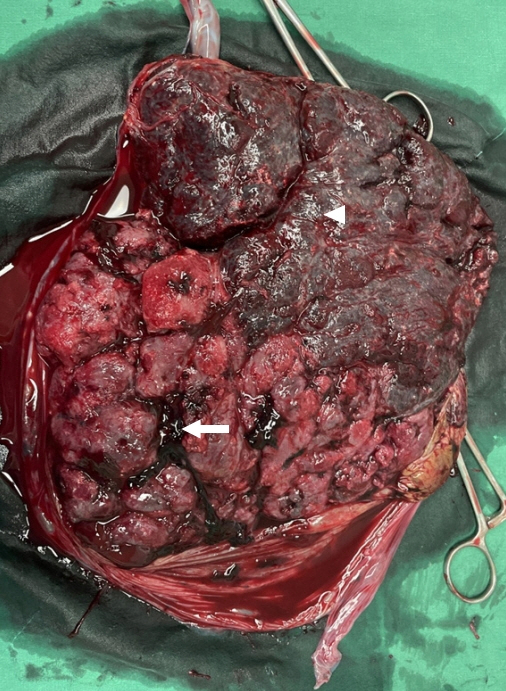J Yeungnam Med Sci.
2022 Apr;39(2):150-152. 10.12701/yujm.2021.01060.
Twin anemia polycythemia sequence in a dichorionic diamniotic pregnancy: a case report
- Affiliations
-
- 1Department of Obstetrics and Gynecology, Yeungnam University Hospital, Daegu, Korea
- 2Department of Obstetrics and Gynecology, Daegu Catholic University School of Medicine, Daegu, Korea
- KMID: 2529273
- DOI: http://doi.org/10.12701/yujm.2021.01060
Abstract
- Complications related to the vascular anastomosis of the placental vessels in monochorionic twins are fatal. The clinical syndromes of feto-fetal transfusion include twin anemia polycythemia sequence (TAPS), twin-twin transfusion syndrome, and twin reversed arterial perfusion sequence. We present an extremely rare case of TAPS in a dichorionic diamniotic pregnancy. A 36-year-old woman, gravida 0, para 0, was referred to our hospital with suspected preterm premature membrane rupture. Although her pelvic examination did not reveal specific findings, the non-stress test result showed minimal variability in the first fetus and late deceleration in the second one. An emergency cesarean section was performed. The placenta was fused, and one portion of the placenta was pale, while the other portion was dark red. The hemoglobin level of the first fetus was 7.8 g/dL and that of the second one was 22.2 g/dL.
Keyword
Figure
Reference
-
References
1. Lewi L, Jani J, Blickstein I, Huber A, Gucciardo L, Van Mieghem T, et al. The outcome of monochorionic diamniotic twin gestations in the era of invasive fetal therapy: a prospective cohort study. Am J Obstet Gynecol. 2008; 199:514. e1-8.2. Lopriore E, Middeldorp JM, Oepkes D, Kanhai HH, Walther FJ, Vandenbussche FP. Twin anemia-polycythemia sequence in two monochorionic twin pairs without oligo-polyhydramnios sequence. Placenta. 2007; 28:47–51.3. de Villiers SF, Slaghekke F, Middeldorp JM, Walther FJ, Oepkes D, Lopriore E. Placental characteristics in monochorionic twins with spontaneous versus post-laser twin anemia-polycythemia sequence. Placenta. 2013; 34:456–9.4. Slaghekke F, Kist WJ, Oepkes D, Pasman SA, Middeldorp JM, Klumper FJ, et al. Twin anemia-polycythemia sequence: diagnostic criteria, classification, perinatal management and outcome. Fetal Diagn Ther. 2010; 27:181–90.5. Tollenaar LS, Slaghekke F, Middeldorp JM, Klumper FJ, Haak MC, Oepkes D, et al. Twin anemia polycythemia sequence: current views on pathogenesis, diagnostic criteria, perinatal management, and outcome. Twin Res Hum Genet. 2016; 19:222–33.6. Zilliox M, Koch A, Favre R, Sananes N. Unusual twin anemia-polycythemia sequence in a dichorionic diamniotic pregnancy. J Gynecol Obstet Hum Reprod. 2019; 48:359–61.7. Tollenaar LS, Prins SA, Beuger S, Slaghekke F, Oepkes D, Lopriore E. Twin anemia polycythemia sequence in a dichorionic twin pregnancy leading to severe cerebral injury in the recipient. Fetal Diagn Ther. 2021; 48:321–6.8. Movva VC, Rijhsinghani A. Discrepancy in placental echogenicity: a sign of twin anemia polycythemia sequence. Prenat Diagn. 2014; 34:809–11.
- Full Text Links
- Actions
-
Cited
- CITED
-
- Close
- Share
- Similar articles
-
- Prenatal diagnosis of spontaneous twin anemia-polycythemia sequence and postnatal examination of placental vascular anastomoses
- A Case of Spontaneous Twin Anemia-Polycythemia Sequence
- A case of Vascular Anastomoses in Dichorionic Diamniotic-Fused Placentas Resulting in "Pseudo" Twin-to-Twin Transfusion Syndrome
- Delayed delivery of the second twin
- A rare case of spontaneous live unilateral twin tubal pregnancy with both fetuses presenting with heart activities and a literature review


